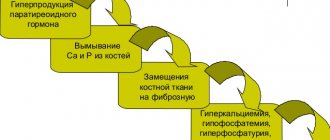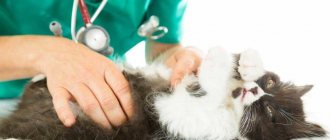Often, thromboembolism in cats develops as a complication that occurs against the background of other, no less dangerous internal disorders. The disease is characterized by acute disruption of blood flow in the vessels, caused by blockage of the artery by a blood clot. The pathology is very dangerous, because a thrombus migrating through the vessels can block the lumen, resulting in paralysis or paresis of the hind limbs, accompanied by necrotic changes in the surrounding tissues.
Causes
Thrombosis in cats is often a consequence of the progression of chronic heart diseases in the pet’s body, such as cardiomyopathy, arterial hypertension, etc. A blood clot often forms in the left atrium, from where it migrates with the blood flow to the farthest parts of the aorta. Thromboembolism can be arterial and venous, and a clot forms much less frequently in the lumen of the arteries. The reasons why a cat may develop thrombosis are:
- infections;
- sepsis;
- severe poisoning;
- cardiovascular disorders;
- diseases of oncological nature;
- presence of enzymes in the blood;
- mechanical damage affecting vascular structures;
- previous surgical treatment.
What symptoms are you worried about?
Depending on the location, the disease is accompanied by different symptoms, one of which is cold pads.
Signs of illness in a cat are determined by the location of the blood clot. Typical symptoms of thrombosis are:
- Loss of coordination of movements, severe lameness.
- If the clot is located in the femoral artery, the animal's hind legs are paralyzed. The muscles of the limbs become very tense and hard.
- The pads become pale and cold.
- When the clot is localized in the arteries of the kidneys, the animal suffers from pain in the lumbar region. Due to impaired kidney function, the body becomes intoxicated, and the cat suffers from nausea and vomiting.
- Blockage of the abdominal aorta is accompanied by severe pain when palpating the abdomen. In addition, the cat suffers from gastrointestinal disorders; blood particles can be seen in the stool.
- If a blood clot clogs the blood vessels of the brain, the pet suffers from epileptic seizures, and in severe cases, coma occurs.
- The affected vessel in the lungs causes the development of symptoms such as a dry, painful cough, shortness of breath, decreased pulse, and pale mucous membranes.
If a cat's aorta is blocked by a blood clot and the blood clot comes off, it is impossible to save the animal. Therefore, if the owner notices that the pet’s condition has deteriorated and characteristic symptoms of the disease are present, it is dangerous to delay a visit to the veterinarian.
Thromboembolism in cats
Thromboembolism is a concomitant complication of many diseases, which is caused by blood clotting in blood vessels and their complete or partial blockage by a thrombus.
A thrombus can block the blood flow of both large vessels (aorta and pulmonary artery) and smaller ones (renal, mesenteric, brachial, cerebral vessels), resulting in tissue ischemia, causing serious disorders.
The age, type and sex of the animal, all these indicators do not protect against the possibility of the occurrence and development of thromboembolism.
Causes of thromboembolism in cats
There are many reasons for thromboembolism, here are just a few of them:
- blood flow disturbance
- damage to the vessel walls
- release of enzymes into the blood
- sepsis and infections
- tumor diseases
- heavy bleeding
- poisoning
- surgical interventions
- heart diseases
- and others…
Symptoms of thromboembolism in cats
Symptoms of thromboembolism in cats depend on the location of the process. With aortic thromboembolism, the following symptoms are observed: lameness, altered gait of the animal. When examining and palpating the hind limbs, paresis or paralysis of both hind limbs is revealed. The muscles on them become very hard and painful. Externally, you can notice the pallor of the paw pads and claws.
Lower back pain, vomiting and a rapid increase in the amount of nitrogenous metabolic products in the blood, due to impaired renal function, all this may indicate thromboembolism of the renal arteries.
Sharp pain in the abdominal area without a specific localization, vomiting and diarrhea, often mixed with blood, these symptoms are characteristic of thromboembolism of the mesenteric arteries.
Thromboembolism of the blood vessels of the brain can be determined due to clear signs: seizures, coma, lesions of the vestibular apparatus.
Thromboembolism of the pulmonary artery; at the first glance at the animal, breathing problems, coughing, weakness and an anxious state of the animal are noted. A detailed examination of the pet can reveal rapid shallow breathing, weak pulse, swelling of the jugular veins, and pale mucous membranes.
The danger of thromboembolism lies in the high degree of mortality in cats, primarily due to blockage of blood vessels, and ischemic toxins cause significant damage to the cat’s body when they enter the bloodstream, they have a pathogenic effect on vital organs and systems.
For a positive outcome of thromboembolism, the most important thing is to contact highly qualified veterinarians in a timely manner. As soon as possible, you need to make a correct diagnosis and prescribe the necessary treatment measures. All this will help save lives and minimize damage to your pet’s health.
Diagnosis of thromboembolism
With pronounced clinical signs, diagnosing thromboembolism is not difficult. If the symptoms of this disease are unclear, a series of diagnostic measures should be urgently carried out.
Blood is taken from the cat for a biochemical blood test, and a study is also carried out to determine the blood clotting time.
In addition to blood diagnostics, it is necessary to perform an ultrasound of the heart (echocardiography), this procedure allows you to visualize the heart, determine anatomical and topographical features, reduction or enlargement of the atria and ventricles, and assess myocardial contractility.
To get a complete picture of the animal’s condition, a veterinarian performs electrocardiography.
When diagnosing thromboembolism, radiography (angiography) is mandatory.
Angiography is a contrast X-ray examination of blood vessels, which allows one to study the functional state of the vessels and the extent of the pathological process.
Treatment of thromboembolism in cats
Treatment of thromboembolism in cats directly depends on how much time has passed since the occurrence of this complication and the visit to the veterinary clinic.
Taking measures to restore blood flow through a blocked blood vessel. This problem is solved by surgical intervention. The aorta is opened to remove the blood clot, thereby freeing blood flow and preventing further continuation of coronary artery disease.
Infusion therapy is carried out to preserve the liquid part of the blood in the vascular bed.
Thrombolytic drugs are prescribed to prevent the formation of new blood clots. The use of these drugs should be carefully monitored by a veterinarian to avoid bleeding and hemorrhagic complications.
conclusions
It should be borne in mind that thromboembolism is only a complication of the underlying disease, and in addition to treatment and elimination of the consequences of thromboembolism, it is necessary to carry out therapeutic measures to solve the underlying disease.
Cats with thromboembolism are recommended to stay in the hospital (intensive care unit), as the pet needs rest and protection from stress, as well as control over nutrition. With inpatient treatment, under the watchful supervision of a veterinarian in the intensive care unit, the animal’s chances of a full recovery and minimizing the consequences of this complication increase significantly.
With proper treatment and prompt access to a specialized clinic, most pets remain alive, and limb function is fully or partially restored.
Animal owners should remember that the result of treatment for thromboembolism depends not only on the professionalism of the veterinarian, but also on many associated factors, such as: the severity of the cat’s underlying disease, the general physiological condition of the animal, the speed of contacting the veterinary clinic, and strict adherence to the doctor’s instructions.
Based on the above, it is necessary to draw the following conclusion that when treating thromboembolism in cats, careful predictions should be made regarding the animal’s recovery.
veterinarian Avdasheva Elena Sergeevna
Source: https://oncovet.ru/kardiologiya/tromboemboliya-u-koshek
Diagnostic measures
If there are signs of the disease, it is necessary to conduct a diagnosis, which includes electrocardiography.
If a cat suddenly loses its hind limbs, or there are other signs of thromboembolism, it is necessary to urgently take the pet to the hospital. After an initial examination and history taking, the doctor will give a referral to undergo a number of such diagnostic procedures:
- blood chemistry;
- Ultrasound of the heart;
- angiography;
- electrocardiography.
Diagnosis of pulmonary embolism
Given the transience of the disease and the high mortality rate, in most cases the diagnosis is made based on the clinical picture. It is of great importance to carefully collect anamnesis and determine the presence of diseases such as phlebothrombosis and thrombophlebitis.
Instrumental and laboratory diagnostic methods are usually carried out in parallel with the treatment started and include:
- Duplex scanning of the vessels of the lower extremities (to find the source of thromboembolism).
- Ultrasound of the pelvis in women.
- EchoCG.
- D-dimer level measurement.
- MSCT with contrast of the chest organs (to confirm or exclude the diagnosis).
- Angiopulmonography and ileocavagraphy (the most reliable way to make a diagnosis and clarify the source from the inferior vena cava system).
Diagnosis is carried out if the patient’s condition allows.
What treatment is prescribed?
Conservative
The earlier a cat is diagnosed with thrombophlebitis, the more favorable the prognosis for recovery. Drugs that prevent increased blood clotting will help restore blood flow in the femoral, abdominal, renal or pulmonary arteries. Heparin injections have proven themselves well, thanks to which they can successfully combat blood clots. However, the drug "Heparin" has many side effects, so the veterinarian must prescribe the dosage and treatment regimen. In addition to the use of thrombolytics, vitamins and agents that increase the animal’s immunity are additionally prescribed.
Surgical
Surgical intervention involves crushing the clot using a catheter inserted into the vessel.
Surgery to remove a blood clot is rarely prescribed. This is due to the fact that the procedure is very complex, is carried out only in specialized clinics, and even successful implementation does not guarantee the absence of relapses. Rheolytic thrombectomy is often prescribed to treat thrombophilia. The surgery is performed using general anesthesia. During the operation, a catheter is inserted into the affected vessel, with the help of which it is possible to break up the clot. In especially severe cases, when necrotic changes progress in the tissues surrounding the blocked vessel, the veterinarian will advise euthanizing the cat so that he does not die in agony.
Thromboembolism in cats and its causes and how to treat
Thromboembolism in cats is a pathology characterized by the formation of blood clots in blood vessels and accompanies many diseases.
The thrombus partially or completely blocks the vascular bed in small capillaries, medium renal, mesenteric, hepatic arteries, etc., as well as in large, main vessels - the aorta, pulmonary artery.
Poor blood flow, lack of nutrition and oxygen supply to cells leads to irreversible consequences, necrosis and cessation of the functioning of organs and systems.
Thromboembolism: what is it, causes and who is predisposed
There is no breed or age classification for thromboembolism in cats. Pathology can be found in both kittens and middle-aged and older animals. A disease of a polyetiological nature and the formation of blood clots may be associated with:
- neoplasms of various origins;
- vascular injuries;
- penetration of enzymes, bacteria, etc. into the blood;
- heavy bleeding;
- poisons;
- surgical interventions;
- heart disease, etc.
To establish what exactly formed the basis of the disease is the primary task of the veterinarian at the RosVet VC.
Therefore, when a cat enters the clinic, a full examination of the animal is carried out, laboratory tests are done and an anamnesis is collected.
It is advisable for the owner to tell in detail what preceded the appearance of symptoms of thromboembolism, describe the cat’s behavior, whether or not there were injuries, surgeries, or poisoning.
Clinical picture of thromboembolism
Symptoms depend on the location of the process and which particular vessel is blocked by a thrombus. Aortic thromboembolism manifests itself in altered gait, lameness, paresis or paralysis of the hind legs. The muscles are hard and painful, the paw pads and the base of the claws are pale (no blood flow).
Other symptoms of thromboembolism:
- renal arteries - vomiting, lower back pain, rapid increase in nitrogen metabolism products in the blood (renal dysfunction);
- mesenteric arteries - acute abdominal pain of unclear localization, diarrhea, vomiting, stool mixed with blood;
- brain – coma, seizures, dysfunction of the vestibular apparatus;
- pulmonary artery - cough, weakness, breathing problems (superficial), severe cat anxiety, weak pulse, pale mucous membranes and swollen jugular veins.
Thromboembolism is a highly fatal disease in cats. In addition to the cessation of blood supply to organs and tissues, during ischemia there is an accumulation of toxins, which, when released into the blood, poison the body.
It is important to know! In thromboembolism, time plays an important role. The sooner the owner contacts the RosVet EC, the higher the chance of removing the blood clot, restoring blood flow and saving the cat. .
Diagnostic measures
Pronounced clinical signs help to quickly make an actual diagnosis and begin treatment. In case of hidden or unclear manifestations, it will be necessary to conduct a series of studies to exclude similar pathologies.
Do:
- blood chemistry;
- ESR, blood clotting rate;
- Ultrasound of the heart, ECG.
Using echocardiography, you can visualize the heart and its chambers, note the increase or decrease of the ventricles and atria, and assess myocardial contractility.
Angiography – x-ray of the heart, contrast study of blood vessels, a mandatory procedure if thromboembolism is suspected. Allows you to assess the functional state of blood vessels and the extent of the spread of the pathological process.
Prognosis for the disease
Thromboembolism is always secondary and is a complication of the underlying disease. Therefore, without eliminating it, one cannot actually expect a positive treatment result, even if the removal of the blood clot and stabilization of the cat were successful.
The animal is placed in the ICU, stress is minimized, rest is provided, diet is provided - all these measures increase the chance of a successful outcome and eliminate the consequences of the disease. With timely treatment and prompt treatment, the likelihood of death is reduced significantly and the prognosis for thromboembolism remains favorable.
If you notice atypical symptoms, the cat's behavior has changed, there are signs of respiratory failure, paralysis, etc. – don’t hesitate! Urgently call the RosVet EC by phone: +7 (495) 256-11-11, around the clock and bring your cat for examination and surgery.
Source: https://Ros-Vet.ru/koshki/tromboemboliya-u-koshek-prichiny-i-prognoz-po-zabolevaniyu/
Survival
It is important for cat owners to know that survival rates depend on timely diagnosis and treatment of thromboembolism. If the clot does not completely block the artery and the diagnosis is made on time, with the help of thrombolytics it will be possible to achieve its resorption and prevent the formation of a new one. Otherwise, the presence of a blood clot contributes to general intoxication of the body, and if the vein is completely blocked, the surrounding tissues do not receive enough necessary nutrients, which is why irreversible necrotic processes begin to progress in them, a complication of which is the death of the four-legged friend.
Clinical picture
Thromboembolism is characterized by sudden onset; signs of the disease develop very rapidly. Quite abruptly, pronounced depression and a complex of neurological disorders arise in the animal. His behavior indicates that the patient is experiencing pain, but where exactly is not clear.
In the video there is a cat with thromboembolism. Flaccid paralysis of the pelvic limbs.
The basis of neurological symptoms is ischemic damage to nerve tissues, because they are most vulnerable to oxygen deficiency. Already 3 minutes after the disruption of blood circulation in them, signs of ischemia develop, the gray matter of the spinal cord is especially susceptible to necrosis. The complexity of the disease can be judged based on the established degree of neurological disorders. In our veterinary clinic, each case was accompanied by paresis and paralysis with symptoms of damage to the lower motor neurons (flaccid paralysis); weakening or complete absence of reflexes, decrease or disappearance of pain sensitivity. There are monoparesis, paraparesis and tetraparesis.
In this video, a cat is paraplegic as a result of thromboembolism.
Prevention
According to the results of studies conducted by veterinarians, the life expectancy of cats diagnosed with thromboembolism is on average 3 months. up to 1.5-2 years. There is very little chance that a sick pet will be able to return to a full life. Often, the animal remains deeply disabled until the end of its days, unable to move normally and independently cope with its natural needs.
There are no specific prevention methods that can prevent this dangerous disease. If one of the kitten’s parents has been diagnosed with thromboembolism, it is important for the owner to monitor the pet’s nutrition from childhood, monitor the completeness and balance of the food, and prevent the cat from overeating in order to prevent obesity. In addition, it is important to prevent injury to the animal and prevent poisoning by chemicals.











